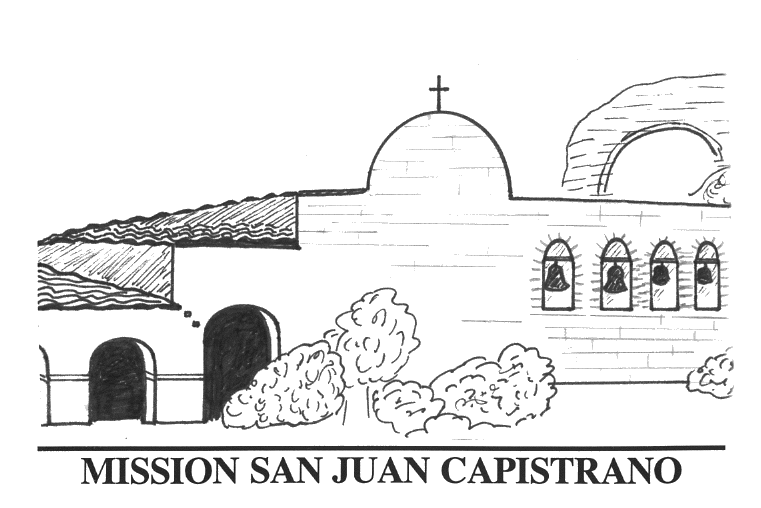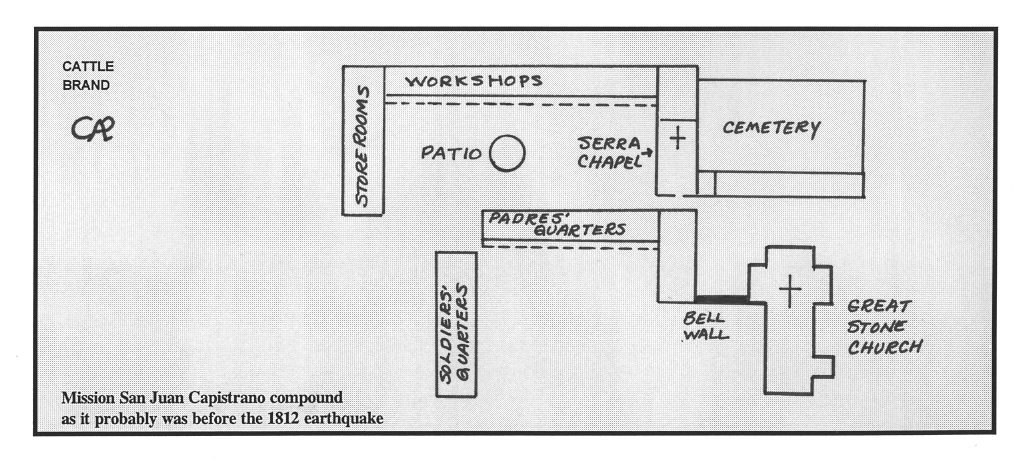| ||||
|
| ||||
|
MISSION
SAN JUAN CAPISTRANO
Ortega Hwy. & Camino
Capistrano
(P.O. Box 697)
San
Juan Capistrano, CA
92693
Established: November 1, 1776
By: Father Junípero Serra, Franciscan missionary, President of the missions.
Order: 7th of the 21 missions.
Location: 70 miles north of San Diego, less than three miles from the Pacific Ocean.
Named: In honor of St. John of Capistran (Italy), a 15th century religious scholar. Also known as The Jewel of the Missions.
California Historical Landmark No. 200
DESIGN OF THE MISSION
Church: Now in ruins; known as the Great Stone Church, 180 feet long, 40 feet wide. Made of yellow sandstone quarried six miles away, held together with limestone mortar.
Style: Cathedral-like grand style with a cruciform, or cross, design (one of two missions in this style). Roof composed of seven masonry domes, five over the long nave of the church and one over each wing of the transept. The design and elaborate stone treatment were the work of Isidor Aguilar, an expert stonemason from Mexico, who was in charge of the construction.
Walls: Vary in thickness, up to seven feet.
Bell Tower: The Great Stone Church had a massive bell tower, 120 feet tall with a gilded rooster weathervane on top. It held four bells cast in 1796 and 1804. These four bells (two large and two small) now hang in openings in a low campanario (bell wall).
Mission Compound: A patio around which the compound was built was irregular in shape, each side having a different length. The compound covered about an acre of land, and, in addition to living quarters, had buildings for storage; workshops for making candles, soap, shoes, hats, blankets and harness; a metal-working furnace, olive press; barracks for the soldiers that protected the mission; a jail and ammunition storage.
Mission Grounds: San Juan Capistrano was a prosperous mission with fields of grain, vegetables and fruit. The climate was moderate, and water was easily accessible from the nearby streams. Eight ranchos (covering most of what is now Orange County) were owned, on which 20,000 head of cattle and sheep grazed. Much of the mission's wealth came from the sale of hides to New England shoe factories. A description of the loading of hides onto cargo ships comes from Dana's Two Years Before the Mast, which tells of the stiff hides being thrown from the top of the cliffs to the beach 280 feet below, where they were carried out to the ships.

EARLY HISTORY
1775 Father Lasuén dedicated the site, set up a cross, and began to build a church. Work stopped when word came of the attack on Mission San Diego. The mission bells were buried; the Franciscans went to the presidio for safety.
1776 Father Serra found the cross still in place. The bells were dug up and hung from a tree, the site was rededicated on November 1, and a chapel of poles plastered with mud was erected.
1777 First adobe church, called Serra Chapel, was erected.
1791 Bell tower built for the bells which had been hanging from a tree since 1776.
1796-1806 Stone church under construction, with local workers carrying boulders from the quarry six miles away. A two-day fiesta in September 1806 brought many people to celebrate the completion of the church.
1812 In December an earthquake destroyed the church and bell tower, killing many Tongva (Juaneño) Indians gathered there. The bells, stone baptismal font, some statues and pictures were saved. Church services were held in Serra Chapel.
1813 Campanario built to hold the bells.
1818 Pirate Hippolyte Bouchard attacked the mission and burned several buildings.
1833 Mission secularized, taken from the Catholic Church by the government.
1845 Mission sold by the Governor to his brother-in-law.
1865 Mission returned to the Church. An attempt at restoration did more damage.
1895 Landmarks Club of Los Angeles saved Serra Chapel from falling apart and restored a small section of the quadrangle.
1910-1920 Father St. John O'Sullivan did major restoration of Serra Chapel; by 1924 services being held again.
THE MISSION TODAY
There has never been an attempt to rebuild the Great Stone Church, and its ruins have changed little over the century. Father O'Sullivan concentrated on restoring Serra Chapel and preventing further decay of the other ruins. Serra Chapel is thought to be the only building still existing where Father Serra preached. Its ornate altar, installed in the 1920's, is from Barcelona, Spain, and is over 300 years old. The statue of Father Serra and a native youth that stands near the mission entrance, as well as the Moorish fountain in the plaza garden, were added in the 1920's.
Buildings around the quadrangle have been restored over the years. Living history days portray life in the mission period. There are reconstructions of the tallow ovens where soap and candles were made, tanning vats for hides, and metal-working furnaces. Many concerts, festivals, and exhibits are held at the mission throughout the year. The extensive grounds, pools, and gardens make the ruins of the Great Stone Church look beautiful.
The best-known feature of San Juan Capistrano is the return of the swallows to build their nests of mud and saliva against the arches of the ruins. Each year, for as long as people can remember, the swallows have returned around March 19, St. Joseph's Day. A week-long fiesta greets the swallows, who stay at San Juan Capistrano until about October 23.
